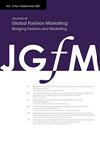The pink bias: Consumption choices of pink-colored products
IF 5.5
Q2 BUSINESS
引用次数: 1
Abstract
ABSTRACT The purpose of this paper is to contribute to a better understanding of the role of the heterosexual orientation on men’s product choices in different consumption contexts. The research provides empirical evidence for a bias – here called pink bias – that leads male consumers to avoid consumption of pink-colored products because of a gender-related prejudice. An experimental study investigated the interplay of the consumption context (private/public) and product type (utilitarian/hedonic), and used heterosexual orientation as moderator. The findings confirmed the existence of a pink bias, according to which men tend to avoid consumption of pink-colored products, especially in public circumstances. In male consumers who feel less heterosexual, this effect could be driven by the fear that consuming pink-colored products in public contexts would “expose” their sexual orientation and align them with femininity. Moreover, pink-colored products could find success among heterosexual males only when they are exclusively for private use.粉红色偏好:粉红色产品的消费选择
摘要本研究的目的是为了更好地理解异性恋取向在不同消费情境下对男性产品选择的影响。这项研究为一种偏见提供了经验证据,这种偏见在这里被称为粉红色偏见,它导致男性消费者由于与性别有关的偏见而避免消费粉红色的产品。一项实验研究以异性取向为调节因子,考察了消费语境(私人/公共)与产品类型(功利/享乐)的相互作用。研究结果证实了“粉色偏见”的存在,即男性倾向于避免消费粉色产品,尤其是在公共场合。对于那些觉得自己不那么异性恋的男性消费者来说,这种影响可能是由于他们担心在公共场合消费粉红色的产品会“暴露”他们的性取向,并使他们与女性气质联系在一起。此外,粉色产品只有在私人使用时才会在异性恋男性中获得成功。
本文章由计算机程序翻译,如有差异,请以英文原文为准。
求助全文
约1分钟内获得全文
求助全文
来源期刊

Journal of Global Fashion Marketing
BUSINESS-
CiteScore
6.90
自引率
31.60%
发文量
34
期刊介绍:
The Journal of Global Fashion Marketing is a quarterly journal that publishes peer-reviewed conceptual and empirical papers and business cases of original works that significantly contribute to the overall advancement of marketing theory, research, and practice in fashion, design, and culture. JGFM endeavors to be a “global bridge” connecting marketing scholars and practitioners in fashion, design, and culture throughout the world. We publish high-quality scholarly articles on marketing written by contributors representing the leading academic authors. As we state on the cover of every issue, our positioning statement, our value added to the marketing scholar readership, is truly to “Bridge Fashion and Marketing” 1. Monitor and analyze global fashion marketing trends. 2. Generate and integrate new ideas and theories related to fashion, luxury, and culture marketing theory and practice. 3. Apply new research methods and techniques in fashion, luxury, and culture marketing. 4. Explore and disseminate cutting edge fashion marketing practices. JGFM welcomes manuscripts that provide fresh, innovative insight to any topic in the field of fashion, luxury, and culture marketing. Both conceptual and empirical works are valued, so long as the manuscript addresses substantive issues in marketing.
 求助内容:
求助内容: 应助结果提醒方式:
应助结果提醒方式:


